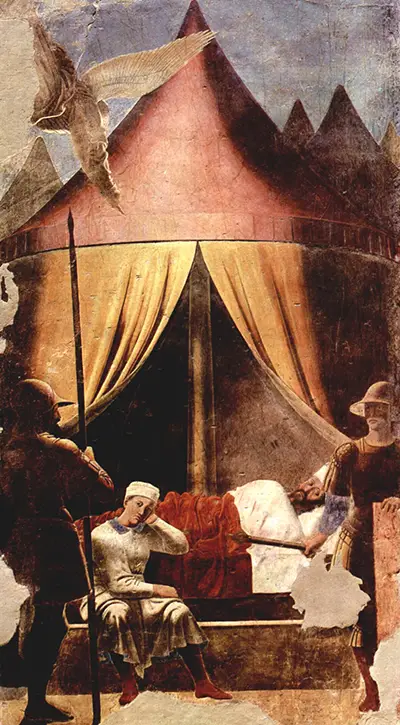As part of the Legend of the True Cross fresco in the Basilica of San Francesco in Arezzo is the The Dream of Constantine by Pierro della Francesca.
This famous series, painted in the chancel of the Basilica, was originally commissioned by the Aretine family and work began in 1447 by Bicci di Lorenzo but he died in 1452. The work was taken over by Pierro della Francesca who completed the task in 1466, with this particular fresco being completed in 1464. A fresco is a technique whereby a painting is made on the wet wall plaster and dries with it, becoming one with structure. It is identified strongly with paintings of the Renaissance, but the technique has been used much further back in time during antiquity.
The Legend of the True Cross is a series of frescoes that tell the story of how relics from the cross that bore Jesus made their way to Europe. Pierro's frescos in this series were inspired by a work called The Golden Legend which is a selection of hagiographies (lives of saints) put together by Jacobus de Varagine around 1260. This collection was popular in Europe in the late middle ages and provided Pierro with a wealth of material for his own work.
The Dream of Constantine depicts the night before the battle at the Milvern Bridge between Constantine’s forces and those of Maxentius. This battle would prove to be the turning point in the conflict and would lead to Constantine coming to power in 312 and Christianity being established throughout the Roman Empire. That night it was claimed that Constantine had a dream about a cross in the sky which was accompanied by the message – 'In hoc signo vinces', which means 'By this sign you shall conquer'. He then went on to use the symbol in place of the traditional Roman eagle as the symbol for his legions in the battle.
The fresco was originally believed to depict a scene at night but this assessment has changed to a dawn setting following a recently completed restoration. Constantine has been depicted lying in a position that some say symbolises the birth of Christianity and the death of paganism in the empire. The stars appear in constellations that have been identified as Ursus minor, Draco and Cassiopeia have been painted in reverse as if seen from the point of view of heaven.




